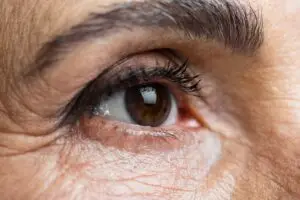A cataract in the eye is a condition in which the natural lens of the eye becomes cloudy, leading to decreased vision. The lens, which is behind the iris and pupil, should be transparent to allow light to pass through the eye and reach the retina smoothly. When the lens becomes cloudy, light cannot pass smoothly, causing blurred vision, glare, decreased visual acuity, and difficulties with night vision. Cataracts can form in one or both eyes, and usually develop slowly over the years.
Types of cataracts in the eye
- Nuclear cataract: This is the most common type of cataract, and it is caused by a chemical change that occurs in the center of the lens (nucleus). This cataract can cause blurred vision and a change in color tone.
- Cortical cataract: This cataract develops in the outer areas of the lens (the shell) and spreads towards the center. It can cause glare and vision problems at night.
- Posterior subbox cataract: This type of cataract develops at the back, under the back box of the lens. This cataract especially affects near vision and reading, and can cause glare in strong light.
- Congenital cataract: This cataract is present at birth or develops in early childhood. It can be caused by genetic inheritance, infections during pregnancy, or other problems.
- Traumatic cataract: a cataract caused by an eye injury. Severe injuries can lead to the rapid development of cataracts.
- Secondary cataracts: Cataracts formed as a result of other eye diseases such as glaucoma or inflammation, or as a result of previous eye surgeries.
cause cataracts in the eye
Cataracts can be caused by a variety of reasons, some related to natural aging processes and others to environmental and genetic factors. The main factors include:
- Aging: The most common cause of cataracts is natural aging of the lens. Over the years, proteins in the lens begin to break down and become cloudy, leading to the development of cataracts.
- Heredity: Genetics can play an important role in the development of cataracts. People who have a family history of cataracts may be at a higher risk of developing the condition.
- Eye injuries: Trauma to the eye, such as a strong blow or penetrating injury, can cause cataracts.
- Exposure to UV rays : Prolonged exposure to ultraviolet (UV) light rays from the sun can increase the risk of developing cataracts.
- Use of steroids: Prolonged use of steroid drugs may lead to the development of cataracts, especially when it comes to eye use.
- Systemic diseases: Medical conditions such as diabetes can increase the risk of cataracts, as they can cause changes in the metabolism of the lens.
- Smoking and alcohol consumption: Smoking and excessive alcohol consumption are considered risk factors for cataracts.
- Exposure to radiation: exposure to radiation, as in therapeutic radiation, can cause the development of cataracts.

Symptoms of cataract in the eye
Cataracts can lead to a variety of symptoms, which get worse over time. Common symptoms include:
- Blurred vision: This is the first and most common symptom of cataracts. The vision becomes blurry and not sharp, like looking through a foggy window.
- Glare: People with cataracts may experience glare in strong light or see halos around light sources, especially at night.
- Faded colors: Cataracts can cause changes in the perception of colors, so that they appear faded or more yellow.
- Difficulty with night vision: Night vision may worsen, making it difficult to drive or operate in low-light conditions.
- Need for strong lighting: People with cataracts may find themselves needing stronger light to read or perform other tasks.
- Change in the number of glasses: Cataracts can cause frequent changes in the number of glasses or contact lenses.
- Double vision: In some cases, cataracts can cause double vision in one eye.
Cataract diagnosis in the eye
Cataract in the eye is diagnosed by an ophthalmologist as part of a comprehensive eye examination. During the examination, the doctor will perform several tests and use different tools to diagnose the condition of the lens and identify the cataract. The tests include:
- Visual acuity test: This test measures your visual acuity by reading rows of letters of different sizes on a vision board.
- Eye examination with a slit lamp: using a slit lamp, the doctor will examine the structure of your eye with great magnification. The slit lamp allows the doctor to see the lens and other parts of the eye in great detail and to identify any changes or cloudiness in the lens.
- Eye examination using pupil dilation: The doctor may dilate the pupils using special eye drops to examine the inside of the eye, including the retina and lens, in more detail.
- Measuring intraocular pressure: This test measures the pressure inside the eye and can help identify other eye problems such as glaucoma.
- Refraction test: This test is used to determine the number of your glasses and can help identify vision changes caused by cataracts.
Eye cataract treatment
Cataract treatment depends on the severity of the symptoms and their impact on daily life. In the early stages of the disease, immediate treatment may not be necessary, and the ophthalmologist may recommend lifestyle changes or the use of optical aids such as glasses or contact lenses. When the cataract significantly affects vision and quality of life, the recommended treatment is cataract surgery. The surgery involves removing the cloudy lens and replacing it with an artificial lens. There are several types of artificial lenses, and the doctor will help you choose the lens that best suits your needs. The operation is usually performed under local anesthesia and does not require prolonged hospitalization. After surgery, most patients experience a significant improvement in vision, but it may take some time to fully recover and adjust to the new lens. It is important to follow the doctor’s instructions after surgery and perform the necessary follow-up tests. Technological progress in recent years has led to the development of new techniques and advanced equipment that make cataract surgery safer and more effective, with excellent results in most cases.
Recovery after eye cataract surgery
Recovery after eye cataract surgery is usually relatively quick, but it is important to follow the instructions given by the attending physician to ensure a successful recovery process and prevent complications. Here are some important tips for the recovery period:
- Avoid pressure on the eye: it is important to avoid rubbing or pressing the operated eye in the first weeks after the operation.
- Use of eye drops: The doctor will prescribe special eye drops to prevent infections and reduce inflammation. You must use the drops as prescribed and observe hygiene when using them.
- Eye protection: You may be asked to wear an eye shield, especially while sleeping, to protect the eye from injury or pressure.
- Avoid strenuous activities: In the first weeks after surgery, you should avoid strenuous activities such as lifting heavy weights, strenuous sports, and swimming in public pools.
- Follow-up examinations: It is important to come to the follow-up examinations prescribed by the doctor to check the condition of the eye and ensure that the recovery is carried out properly.
- Abnormal symptoms: In the case of severe pain, a sharp decrease in vision, or any other abnormal symptom, you should contact your doctor immediately.

Common questions
Can cataracts reappear after surgery? Cataracts do not return after the lens is removed, but a condition called “secondary cataract” is possible in which the box that remains in the eye becomes cloudy. This condition can be treated with a laser. How long does the surgery take? Cataract surgery is usually short and takes about 15 to 30 minutes. Is the surgery painful? The operation is usually performed under local anesthesia, so the patient does not feel pain during the operation. There may be slight discomfort after surgery, but this can be alleviated with pain medication. When can I return to normal activity? Most patients can return to normal activities within a few days to weeks after surgery, but strenuous activities should be avoided for the first few weeks. Are glasses necessary after surgery? In many cases, cataract surgery greatly improves vision and distance glasses may not be needed. However, glasses may still be needed for close reading or work. What are the risks in cataract surgery? Cataract surgery is considered very safe, but like any surgery, there are possible risks such as infections, inflammation, or other rare complications. It is important to discuss the risks and benefits with the doctor before making a decision.
Myths about cataracts in the eye
There are several common myths about cataracts in the eye that can cause confusion and unnecessary worry. Here are some of the common myths and the truth behind them:
- Cataract is a disease of older people only: although cataracts are more common in older people, they can also appear in young people and even in babies.
- Cataract affects only one eye: Cataracts can appear in both eyes, although it may develop at a different rate in each eye.
- Cataract surgery is painful and dangerous: Cataract surgery is one of the safest surgeries and is performed under local anesthesia so that the patient does not feel pain. Most people experience a quick recovery and a significant improvement in vision.
- A cataract must reach an advanced state before it can be treated: there is no need to wait until the cataract reaches a severe state. When the cataract begins to interfere with daily vision, surgery can be considered to treat it.
- Cataract surgery restores vision 100%: Although most patients experience a significant improvement in vision, glasses or contact lenses may still be needed to correct some vision.
Technological advances in cataract treatment
Technology in the field of cataract surgery has advanced impressively in recent years, which has made the surgery safer, faster and more efficient. Here are some of the notable advances:
- Phacoemulsification : This is the most common method of cataract surgery, in which ultrasound waves are used to crush the cloudy lens and pump it out. The method allows for a smaller cut and faster recovery.
- Advanced intraocular lenses: today there is a wide variety of intraocular lenses (IOLs) that are customized to the patient’s needs, including multifocal lenses that allow clear vision at different distances and reduce the need for glasses.
- Femtosecond laser : using this laser allows for more precise and efficient cuts during surgery, which leads to better accuracy and results.
- Personalized surgery planning: Advanced imaging and surgery planning technologies allow the surgery to be customized to each patient’s unique eye structure, which ensures optimal results.
- Advanced surgery systems: state-of-the-art surgery systems enable more precise control and control during surgery, which reduces the risk of complications and improves surgery results.
Advances in the treatment of cataracts in the eye have resulted in a significant improvement in the quality of vision of many patients and in reducing the risks and complications associated with surgery.
Cataract in the eye in old age
Cataracts are one of the most common causes of vision loss in older people. With age, the natural lens in the eye begins to lose its transparency and become cloudy, this process occurs due to a change in the structure of the proteins in the lens. Cataracts in old age affect the quality of life and the ability to perform daily activities, such as reading, driving and watching television. Cataracts can develop gradually and cause symptoms such as blurred vision, glare in strong light, poor night vision and a change in color perception. Over time, the condition can worsen and cause severe vision loss if left untreated. The most effective treatment for cataracts in old age is cataract surgery, in which the cloudy lens is removed and replaced with an artificial lens. The surgery is usually quick and safe, and provides excellent results in most cases. It is important to undergo regular eye examinations and see an ophthalmologist when symptoms of cataract appear to treat the condition as soon as possible.
Cataract in the eye and the relationship to other eye diseases
Cataracts can be associated with other eye diseases, and in some cases eye diseases can worsen the risk of developing cataracts. Some of the common eye diseases that can be associated with cataracts include:
- Glaucoma: This disease damages the optic nerve and can lead to vision loss. There are cases where cataract and glaucoma appear together, and combined treatment may be necessary.
- Diabetic retina (diabetic retinopathy): Diabetics are at higher risk of developing cataracts due to changes in blood sugar. Diabetic retinopathy can worsen the condition and affect general vision.
- Intraocular inflammation (uveitis): Chronic inflammation inside the eye can cause the development of cataracts. The treatment of inflammation is important to prevent further complications.
- Age-related retinal degeneration ( AMD ): This disease affects the central part of the retina and can cause central vision loss. People with AMD may be at higher risk of developing cataracts.
- Dry eye syndrome: a condition in which there is a lack of moisture in the eyes. Although there is no direct link between dry eye and cataracts, people with dry eye syndrome may experience more complex symptoms after cataract surgery.
Monitoring and early treatment of these eye diseases can help prevent further complications and improve the quality of vision and life of the patients. It is important to contact an ophthalmologist for regular examinations and receive appropriate medical advice for the condition of the eye and general health.
Innovations in research
Research in the field of cataracts in the eye is developing at a rapid pace, and brings with it technological and medical innovations that improve the treatment and the results of surgery. Here are some of the latest innovations in cataract research:
- Development of advanced intraocular lenses: New and advanced intraocular lenses (IOLs) are developed with improved technologies that allow vision correction in all ranges of vision, including near, intermediate and far vision. These lenses reduce the need for glasses after surgery and improve the quality of life.
- Bionic lenses: innovative research develops bionic lenses that can synchronize with the structure of the eye and adjust themselves to lighting conditions and distance. These lenses will be able to improve vision in a dynamic way and enable sharper vision.
- Advanced laser technologies: Femtosecond laser for cataract surgery allows for more precise cuts in the lens and cornea, which improves the accuracy and safety of the surgery. This technology also allows the removal of the cataract in a more efficient way.
- New drug treatments: Research is developing drug treatments that can delay the development of cataracts and reduce the need for surgery. These treatments can include the use of antioxidants and other chemical substances that prevent the clouding process of the lens.
- Advanced biometrics: the use of advanced imaging technologies such as high-frequency ultrasound and OCT scans make it possible to perform accurate measurements of the structure of the eye and to adjust the artificial lens in a personal way to the patient.
- Genetic treatments: Research in the field of genetics identifies certain genes that are related to the development of cataracts. In the future, genetic therapies may help prevent the development of cataracts in people with a genetic predisposition to this condition.
- Stem cells and regenerative medicine: The use of stem cells and regenerative medicine technologies is in research to develop new treatments that can restore the natural lens or repair damage to the eye. These studies are still in their early stages, but they promise great potential for improving cataract treatment.
- A combination of smart technologies: the development of smart surgery systems that use artificial intelligence and advanced algorithms allow doctors to perform the surgery with greater precision and in a shorter time. These systems can help guide the doctor during surgery and prevent complications.
The advanced research in the field of cataracts in the eye continues to bring innovations and new technologies that improve the treatment and the results of surgery, and allow many people to enjoy better vision and an improved quality of life.





